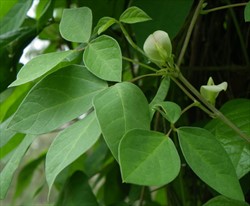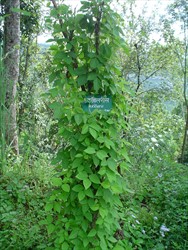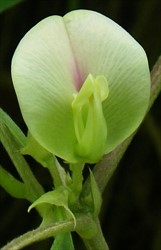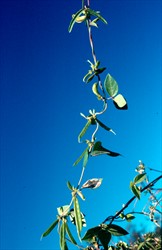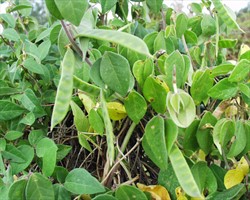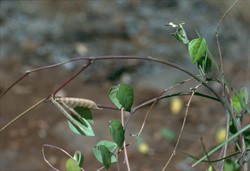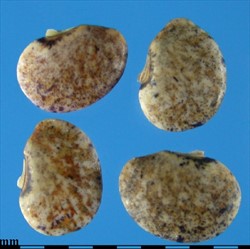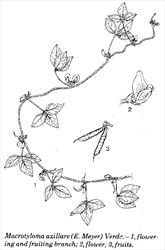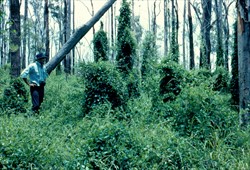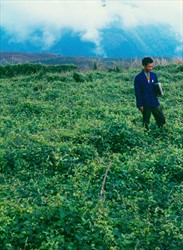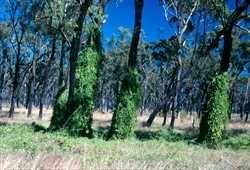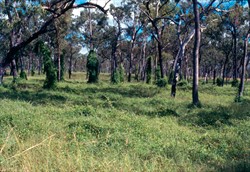Macrotyloma axillare
Tropical Forages
Macrotyloma axillare (E. Mey.) Verdc.
Subordinate taxa:
Macrotyloma axillare (E. Mey.) Verdc. var. axillare
Macrotyloma axillare (E. Mey.) Verdc. var. glabrum (E. Mey.) Verdc.
Macrotyloma axillare (E. Mey.) Verdc. var. macranthum (Brenan) Verdc.
var. axillare: Basionym: Dolichos axillaris E. Mey.
var. glabrum: Basionym: Dolichos axillaris E. Mey. var. glaber E. Mey.
var. macranthum: Basionym: Dolichos axillaris var. macranthus Brenan
Family: Fabaceae (alt. Leguminosae) subfamily: Faboideae tribe: Phaseoleae subtribe: Phaseolinae.
Trailing and twining perennial, with an erect basal stem usually to about 1 cm diameter, developing to 3 cm in unrestricted stands, and with the ability to climb to >10 m up an appropriate framework such as trees; strong woody taproot and rootstock. Stems cylindrical, glabrescent, pubescent or hairy ; no tendency to develop adventitious roots at the nodes. Leaves trifoliolate, with leaflets entire, elliptical, ovate-lanceolate, ovate or subrhombic, 1.1‒7.5 cm long and 0.7‒4.2 cm across; glabrous to pubescent, slightly glossy on upper surface, paler, matt below; stipules ovate-lanceolate, 2‒5 mm long. Inflorescence an axillary raceme, comprising 2‒4 (‒10) whitish to greenish-yellow papilionate flowers, often with a central crimson or purple blotch on the standard; standard oblong-elliptical, 1‒2.4 cm long and 0.6‒1.5 cm across. Pod linear oblong, shortly stipitate, laterally flattened, 3‒8 cm long, and 5‒8 mm broad, glabrous or pubescent, beaked; containing (5‒) 7‒8 (‒9) seeds. Seeds subovoid, rounded or ellipsoid, 3‒4 mm long, 2.5‒3 mm broad, hard and smooth, buff to reddish brown, with sparse to dense black mottling; 50,000‒200,000 seeds per kg.
var. axillare: stems with dense, rarely sparse, spreading hairs. Flowers 1.2–1.5 (‒2) cm long; calyx 4–7 mm long. Pod with beak 3–7 mm long, pubescent.
var. glabrum: stems with sparse, rarely dense, appressed hairs. Flowers 1.3–2 cm long; calyx 4–7 mm long. Pod with beak 5–15 mm long, pubescent or glabrescent.
var. macranthum: stems densely hairy with hairs spreading. Flowers (1.5‒) 2–3 cm long; calyx 7–12 mm long. Pod with beak 3–7 mm long, pubescent.
Africa: umhlanzo wenhliziyo (Zulu); emagonsi, umgonsi (Swaziland)
English: Archer axillaris (Australia); lime-yellow pea, perennial horse gram
French: Archer Dolichos
Latin America: dólicos, macrotiloma (Brazil)
var. axillare
Native:
Africa: Angola; Botswana; Burundi; Cameroon; Democratic Republic of the Congo; Ghana; Guinea; Kenya; Malawi; Mozambique; Namibia; Nigeria; Rwanda; Sierra Leone; South Africa (Cape Province, KwaZulu-Natal, Transvaal); Swaziland; Tanzania; Togo; Uganda; Zambia; Zimbabwe
Indian Ocean: Madagascar
Asia: Yemen
var. glabrum
Native:
Africa: Angola; Botswana; Burundi; Democratic Republic of the Congo; Eritrea; Ethiopia; Kenya; Malawi; Mozambique; Senegal; Somalia; South Africa (KwaZulu-Natal, Transvaal); Swaziland; Tanzania; Uganda; Zambia; Zimbabwe
Indian Ocean: Comoros; Madagascar; Mauritius; Réunion
Asia: Sri Lanka; Yemen
var. macranthum
Native:
Africa: Malawi; Mozambique; Tanzania; Zambia; Zimbabwe
Forage
Mainly used as permanent pasture. Useful for cool season standover and agroforestry. Can be used for cut-and-carry feed or to conserve as hay or silage, but vigorous, twining habit may cause difficulty. Intercropping maize with M. axillare can increase the quantity and quality of the crop residue.
Environment
Used for revegetating degraded land.
Other
Antimicrobial, antifungal and antihelminthic properties. Used in folk medicines and contains biomolecules of pharmacological interest. Potential for genetic improvement of horse gram (Macrotyloma uniflorum).
Soil requirements
Often found on deep stony and sandy loam soils, but also on loams and clay loams. Not well adapted to heavier clays or hard-setting soils. In cultivation, grown on sands to clays, providing they are well drained. Prefers a pH between 6 and 7, but grows successfully between 5.5 and 7.5. Indications are that more acid conditions have an adverse influence on the effectiveness of nodulation of M. axillare, rather than on plant growth per se. Tolerates moderate salinity (4‒10 dS/m). Considered useful in renovating soils that have become unproductive through continuous cultivation. Appears to grow better on less fertile soils, initially growing Eucalyptus spp., than on fertile, previously-rainforest soils where Neonotonia wightii is better adapted.
Moisture
Although found in areas with annual rainfall as low as 375 mm, most collections have been made between about 750 mm and 1,700 mm. In cultivation, it is normally grown in areas with over 1,000 mm/yr, and has been successful up to 3,000 mm/yr. Very drought tolerant, surviving in situations with a very dry 8-month winter-spring season and during hot dry spells in summer, but has no tolerance of waterlogging.
Temperature
Found between 16º N and 31º S, at low altitudes in the subtropics and higher altitudes, up to 2,250 m asl, in the tropics, mostly in areas with an average annual temperature between about 18 and 26 ºC. Classified by some as a "cool tropical legume", it grows best under relatively mild conditions (optimum day/night temperature 26/21 ºC). Growth declines at day temperatures above 28 ºC. Commences growth earlier in the season than most other warm season legumes. Tops are killed by frost, but plants recover from basal shoots. Generally poor long-term persistence in frosted areas.
Light
Has moderate shade tolerance, thriving in agroforestry situations under tree canopies with about 50% light interception.
Reproductive development
Exhibits juvenility in flowering in the year of establishment, but in succeeding years, flowers over much of the growing season. Flowering and seeding may continue until the plants are frosted, or in frost-free areas, continue throughout the winter and early spring. Pods mature 30‒60 days after flowering, depending on temperature during development.
Defoliation
Because of its erect main stem, and no tendency to develop adventitious roots on prostrate stems, M. axillare is susceptible to regular or heavy grazing. Plants become dormant during the cool season, and may be grazed heavily until growth resumes in spring. In non-agroforestry situations where plants do not have the benefit from and protection afforded by trees, rotational grazing with fairly long intervals between grazings is necessary for replenishment and survival of stand. If protected while seeding, pods will shatter and the seed later germinate to thicken the sward. When cut, should be at >30 cm high, to preserve buds on the lower main axis.
Fire
Older plants recover well following fire, and germination of soil seed is enhanced, with a consequent improvement in stand density.
Guidelines for establishment and management of sown forages.
Establishment
Fairly promiscuous in its rhizobial requirements, nodulating most effectively with Bradyrhizobium Group J (CB 1024 in Australia), the strain also used for Lablab purpureus and Cajanus cajan. While hand-harvested seed has high levels of hard seed requiring scarification prior to planting, machine-harvested seed receives sufficient scarification during the threshing process. Normally sown into a well-prepared seedbed at 2‒4 kg/ha seed at a depth of 1‒2.5 cm, although can be established by broadcasting seed onto the surface following severe fire. Good seedling vigour. Grazing should be withheld for a few months after emergence, since young plants are erect and vulnerable to defoliation and trampling.
Fertilizer
Tolerates low fertility, but responds to application of phosphorus fertilizers in low P soils. The adverse effect of declining pH on effectiveness of nodulation suggests that addition of molybdenum may also be of value in more acid soils.
Compatibility (with other species)
Grows successfully with tufted grasses and other twining legumes. If left unchecked, it will grow over other species, which is an advantage in the suppression of shrubby weeds, but a disadvantage where tree recruitment is sought in an agroforestry situation.
Companion species
Grasses: Cenchrus purpureus, Chloris gayana, Megathyrsus maximus, Setaria sphacelata, Urochloa brizantha.
Legumes: Desmodium intortum, D. uncinatum, Macroptilium atropurpureum, Neonotonia wightii.
Pests and diseases
Very low disease incidence. Main disease is legume little-leaf caused by a phytoplasma. Rarely affected by amnemus weevil (Amnemus quadrituberculatus) or rough brown weevil (Baryopadus corrugatus) (both Coleoptera: Curculionidae). Bean fly (Ophiomyia (Agromyza, Melanagromyza) phaseoli Diptera: Agromyzidae) sometimes attacks young seedlings, but not as commonly as with Macroptilium spp. Also susceptible to root-knot nematode (Meloidogyne incognita) and reniform nematode (Rotylenchus reniformis).
Ability to spread
Spreads by virtue of stem elongation and violent shattering of mature pods. Seed is also ingested by cattle, a proportion passing through the animal undigested and germinating in dung pats.
Weed potential
Has become a serious weed in open forest and woodland, where it climbs on woody vegetation, shading tree and understorey canopies and damaging the growth form of developing saplings.
Nutritive value
Crude protein levels range from about 12‒23% of the DM in actively growing material, to 6% in mature, dormant material. Phosphorus levels also decline by up to 50% with age.
Palatability/acceptability
M. axillare is initially not relished by cattle, but once accustomed to it, they eat it readily. It is also suggested that young growth is less palatable than older growth. Leaves are somewhat bitter, probably reflecting moderately high tannin levels.
Toxicity
No record of toxicity.
Dry matter
DM yields under average conditions are usually below 10 t/ha, although on fertile soils under irrigation up to 16 t/ha are possible.
Animal production
Sheep fed a basal diet of maize stover supplemented with M. axillare hay recorded higher dry matter and nitrogen intake, and showed a higher gain in body weight over the maize stover control. Significant improvement in dry season milk production has been recorded in cows with access to a protein bank of M. axillare.
Self-fertile, the flowers being cleistogamous. Diploid, 2n = 20. New cultivars have been produced in Brazil through selection within the existing cultivar, 'Archer', and ultimately in creating crosses between 'Archer' and 'Guatá'. Breeding programs in India have investigated the possibility of transferring desirable traits from M. axillare to the more vulnerable annual crop species, M. uniflorum.
Some difficulty in seed production due to extended flowering period and hence spread of maturity, shattering seed pods, and long trailing stems that tangle machinery. Irrigation a week before harvest can reduce tendency for pods to shatter. Yields of 100‒200 kg/ha are normal, although much higher yields are possible, particularly if header harvest is followed by vacuum harvest.
Tolerant of pre-emergent benfluralin. Seedlings susceptible to acifluorfen, 2,4-DB and 2,4-D, but tolerant of bentazone, fluazifop-butyl and sethoxydim. 2,4-DB can be used on established stands at rates of up to 2.5 kg/ha active ingredient, but not 2,4-D that is lethal even at 0.6 kg/ha active ingredient.
- Long growing season.
- Drought tolerant.
- Grows on "old cultivation" land.
- Little pest or disease problem.
- Intolerant of waterlogging.
- Intolerant of heavy grazing.
- Declines in frequency in frosted environments.
- Environmental weed, particularly in woodland and open forest areas.
Blumenthal, M.J. and Staples, I.B. (1993) Origin, evaluation and use of Macrotyloma as forage -a review. Tropical Grasslands 27:16–29. bit.ly/3awFf8j
Blumenthal, M.J., O'Rourke, P.K., Hilder, T.B. and Williams, R.J. (1989) Classification of the Australian collection of the legume Macrotyloma. Australian Journal of Agricultural Research 40(3):591–604. doi.org/10.1071/AR9890591
Cameron, D.G. (1986) Tropical and subtropical pasture legumes. 10. Axillaris (Macrotyloma axillare): A legume with limited roles. Queensland Agricultural Journal 112:59–63.
Gillett, J.B., Polhill, R.M. and Verdcourt, B. (1971) Leguminosae (Part 3) Subfamily Papilionoideae. In: Milne-Redhead, E. and Polhill, R.M. (eds) Flora of Tropical East Africa. Crown Agents for Overseas Governments and Administrations, London, UK. p. 313–314.
Luck, P.E. (1965) Dolichos axillaris - prospects in Queensland. CSIRO Australian Plant Introduction Review 1:50a–51a.
Staples, I.B. (1992) Macrotyloma axillare (E. Meyer) Verdc. In: Mannetje, L.’t and Jones, R.M. (eds) Plant Resources of South-East Asia No. 4. Forages. Pudoc Scientific Publishers, Wageningen, the Netherlands. p. 161–163. edepot.wur.nl/327785
Verdcourt, B. (1970) Studies in the Leguminosae-Papilionoideae for the 'Flora of Tropical East Africa': III. Kew Bulletin 24:402. doi.org/10.2307/4102845
Verdcourt, B. (1982) A revision of Macrotyloma (Leguminosae). Hooker's Icones Plantarum 38(4):1–138.
'Archer' (ILRI 6756, K5049, CPI 17814, CPI 28696) Released in Queensland, Australia (1966). Origin unknown, arising from an institutional collection from Grassland Research Station at Kitale in Kenya. Vigorous and high yielding in subtropics; producing rapid cover, and retaining leaves until frosted; very drought tolerant. Can become a weed in forest country.
'Guatá' Released in Brazil (late 1980s). Selected from within 'Archer', with 10‒12% more DM production, and higher seed yields.
'Jade' Released in Brazil (2004). Hybrid developed by the Instituto de Zootecnia by crossing 'Archer' and 'Guatá', and selecting for DM and seed production, lower tannin levels in the leaves, and resistance to pests and diseases. Grown successfully with Urochloa brizantha cv. Victoria, and Megathyrsus maximus cvv. Tanzania, Mombaça and Massai.
'Java' Released in Brazil (2004). Hybrid developed by the Instituto de Zootecnia by crossing 'Archer' and 'Guatá', and selecting for suitabilty for intercropping with grasses, and also revegetation of degraded lands.
None reported.
